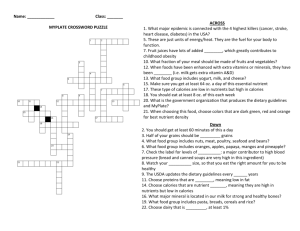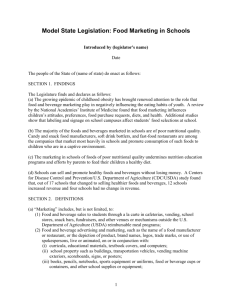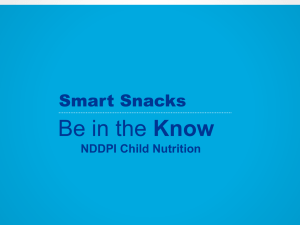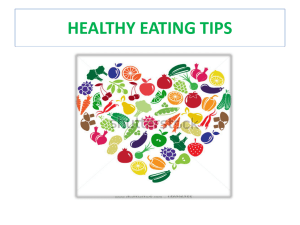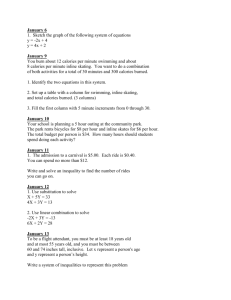Alliance for a Healthier Generation School Beverage Guidelines
advertisement
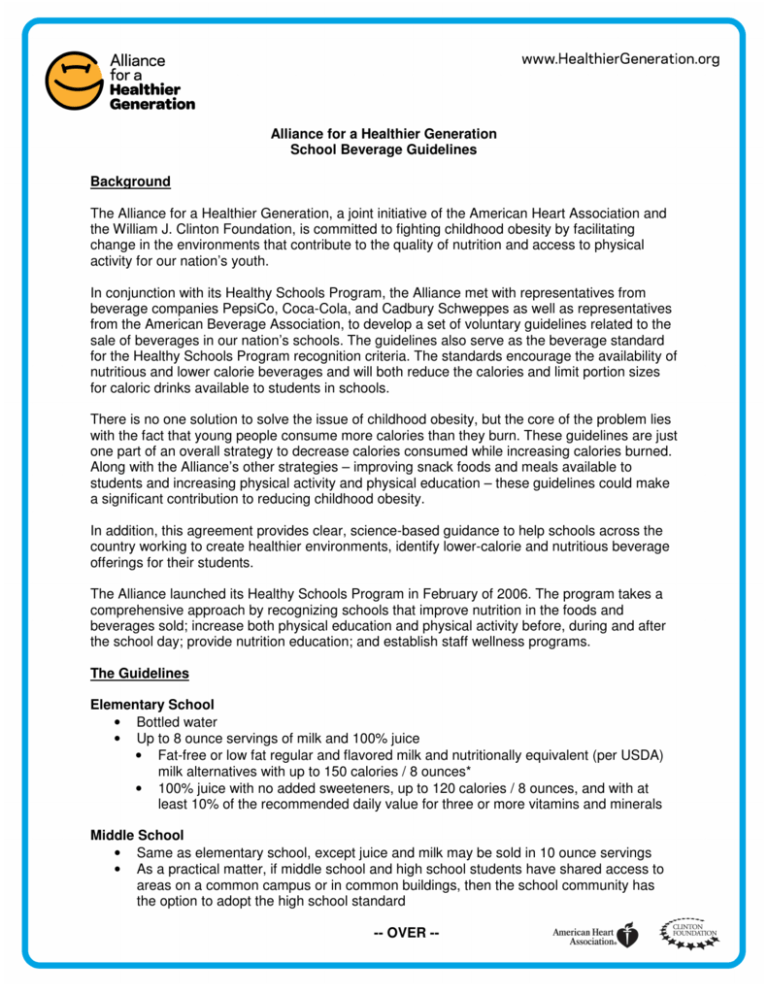
Alliance for a Healthier Generation School Beverage Guidelines Background The Alliance for a Healthier Generation, a joint initiative of the American Heart Association and the William J. Clinton Foundation, is committed to fighting childhood obesity by facilitating change in the environments that contribute to the quality of nutrition and access to physical activity for our nation’s youth. In conjunction with its Healthy Schools Program, the Alliance met with representatives from beverage companies PepsiCo, Coca-Cola, and Cadbury Schweppes as well as representatives from the American Beverage Association, to develop a set of voluntary guidelines related to the sale of beverages in our nation’s schools. The guidelines also serve as the beverage standard for the Healthy Schools Program recognition criteria. The standards encourage the availability of nutritious and lower calorie beverages and will both reduce the calories and limit portion sizes for caloric drinks available to students in schools. There is no one solution to solve the issue of childhood obesity, but the core of the problem lies with the fact that young people consume more calories than they burn. These guidelines are just one part of an overall strategy to decrease calories consumed while increasing calories burned. Along with the Alliance’s other strategies – improving snack foods and meals available to students and increasing physical activity and physical education – these guidelines could make a significant contribution to reducing childhood obesity. In addition, this agreement provides clear, science-based guidance to help schools across the country working to create healthier environments, identify lower-calorie and nutritious beverage offerings for their students. The Alliance launched its Healthy Schools Program in February of 2006. The program takes a comprehensive approach by recognizing schools that improve nutrition in the foods and beverages sold; increase both physical education and physical activity before, during and after the school day; provide nutrition education; and establish staff wellness programs. The Guidelines Elementary School • Bottled water • Up to 8 ounce servings of milk and 100% juice • Fat-free or low fat regular and flavored milk and nutritionally equivalent (per USDA) milk alternatives with up to 150 calories / 8 ounces* • 100% juice with no added sweeteners, up to 120 calories / 8 ounces, and with at least 10% of the recommended daily value for three or more vitamins and minerals Middle School • Same as elementary school, except juice and milk may be sold in 10 ounce servings • As a practical matter, if middle school and high school students have shared access to areas on a common campus or in common buildings, then the school community has the option to adopt the high school standard -- OVER -- High School • Bottled water • No- or low-calorie beverages with up to 10 calories / 8 ounces • Up to 12 ounce servings of milk, 100% juice, and certain other drinks • Fat-free or low fat regular and flavored milk and nutritionally equivalent (per USDA) milk alternatives with up to 150 calories / 8 ounces* • 100% juice with no added sweeteners, up to 120 calories / 8 ounces, and with at least 10% of the recommended daily value for three or more vitamins and minerals • Other drinks with no more than 66 calories / 8 ounces At least 50% of non-milk beverages must be water and no- or low-calorie options * In recognition of the currently limited availability of flavored milk with less than 150 calories / 8 oz and the importance of milk’s natural nutrients in children’s diet’s, flavored milk with up to 180 calories / 8 oz will be allowed under these guidelines until August 31, 2008 so long as schools attempt to buy the lowest calorie flavored milk available to them. Because of unique CA state milk regulations, the calorie limit for fat-free and low fat flavored milk in CA schools is 180 calories / 8 oz with a transition period until August 31, 2008 that allows 210 calories / 8 oz. These guidelines apply to beverages sold on school grounds during the regular and extended school day. (The extended school day includes before and after school activities like clubs, yearbook, band, student government, drama and childcare/latchkey programs.) These guidelines do not apply to school-related events where parents and other adults are part of an audience or are selling beverages as boosters during intermission, as well as immediately before or after an event. Examples of these events include school plays and band concerts. This is a ground breaking development for the health of our nation’s students. The guidelines set a high standard for portion control, nutrition quality, and calorie limits in grades K-12. The Alliance commends the leadership of the beverage industry for working to address health and wellness issues in schools. The Alliance also commends the efforts of the advocates and leaders who have worked to improve the nutrition in their districts, states, and the nation as a whole. This agreement will not undo those efforts. Implementation and Reporting It is the goal of the parties to achieve implementation of these standards in 75% of schools under contract prior to the beginning of the 2008-2009 school year. Parties will strive to achieve implementation for all schools prior to the beginning of the 2009-2010 school year, provided schools and school districts are willing to amend existing school contracts. Beginning in 2007, the American Beverage Association along with Cadbury-Schweppes, CocaCola, and PepsiCo will support an annual analysis of the impact and status of these guidelines. This analysis will include beverage sales to students in all venues in schools, as well as contract compliance broken down by school level and by new vs. existing/amended contracts. Reports will further attempt to distinguish between beverages supplied directly to schools by bottlers and those supplied indirectly through other channels, such as food and beverage distributors and contract operators. The American Beverage Association will annually present this data on its website and/or a press release.
